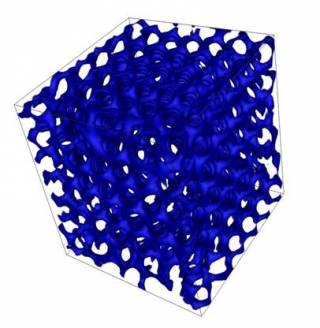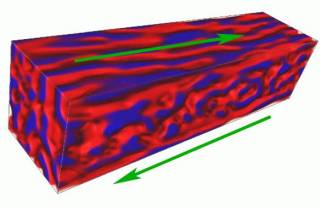Rheological studies of ternary mixtures via lattice Boltzmann simulations
Lattice Boltzmann (LB) schemes have emerged in the past years as a valid tool for simulating the dynamics of complex fluids. Such schemes differ substantially from Continuos Fluids Dynamics as they mimic systems at the mesoscopic level. Various people at the CCS have been involved in the development of LB3D, a bottom up implementation of such technique. LB3D uses MPI libraries in order to run in parallel. It has been tested on a variety of resources and was awarded a gold star for scaling up to 1024 processors. For some values of the densities and interactions parameters, an amphiphilic fluids can assemble into a long range ordered structure, or a crystal, known as gyroid (fig. 1).
 | Fig 1. The discovery of the gyroid has led to the TeraGyroid project, where massive simulations of gyroids were performed on the U.S. TeraGrid in order to inspect the dynamics of defects in such a crystal. |
In particular, LB3D does not impose any "macroscopic" constraints to the dynamics of the system. This is different from top down Lattice Boltzmann models were the dynamics is dictated by an imposed, well crafted, stress tensor. It is therefore natural to study the macroscopic parameters of the fluids under different conditions, such as steady and oscillatory shear. Such study is ongoing and it has been possible to demonstrate Non-Newtonian behaviour of the gyroid and a viscoelastic behaviour.
 | Sheared equilibrium mesophases |
The same "experiments" will be repeated for a ternary mixture similar to the gyroid without long range order to assess how much of this behavior is to credit to the crystal structure of the fluid.
LB3D is able to simulate ternary mixtures, and therefore a careful investigation of the effect of surfactant in the spinodal decomposition is under way. Particular attention is given to the dynamical scaling law and to the domain growth in different regimes. Also, effect of steady/oscillatory shear on spinodal decomposition is studied.
 Close
Close

